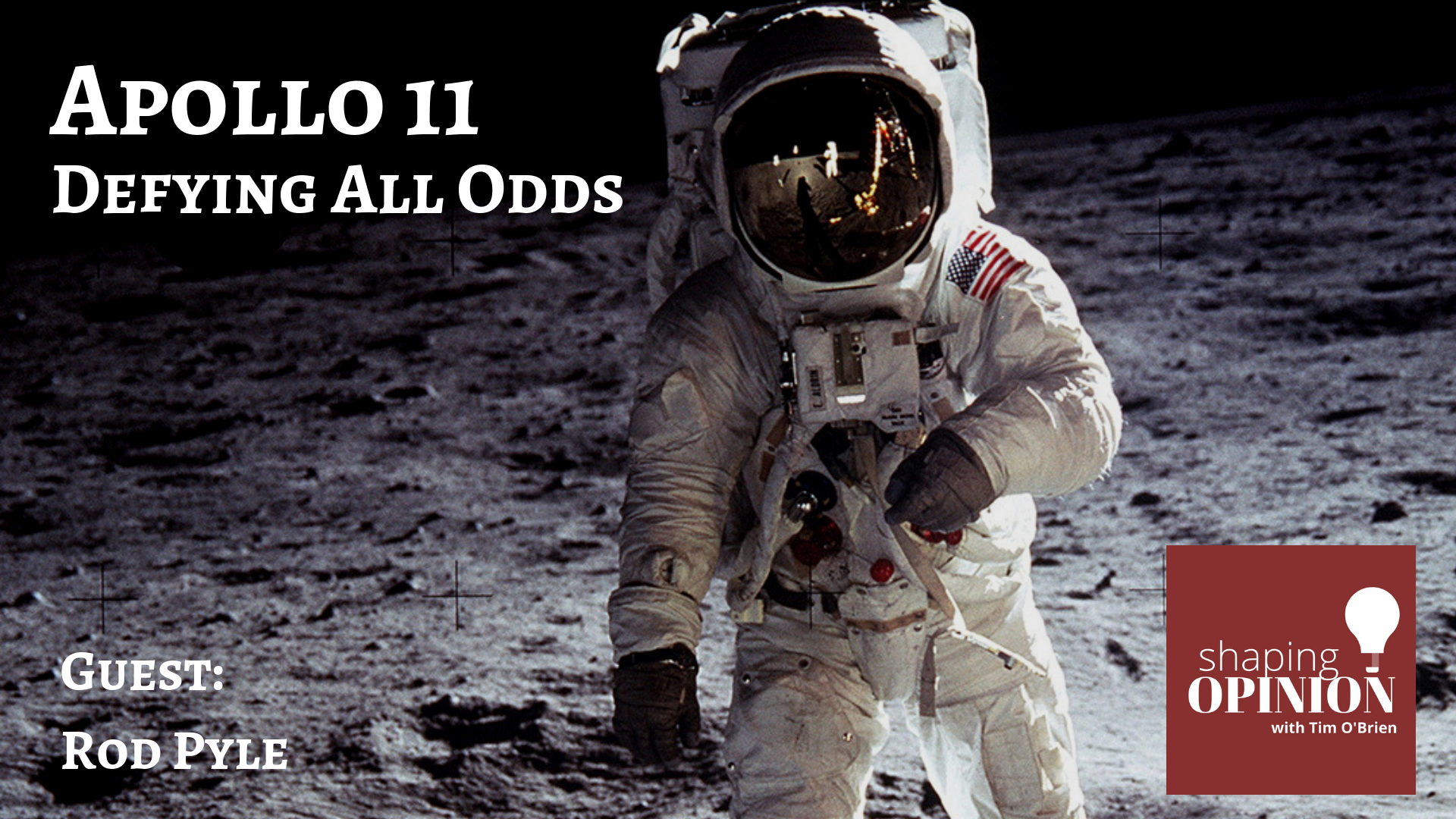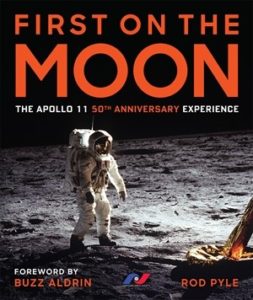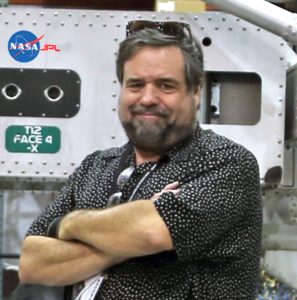Space author, journalist and historian Rod Pyle joins Tim to tell the story you knew and the ones you didn’t about the pinnacle accomplishment for the NASA space program, when man first stepped foot on the Moon thanks to Apollo 11, which is celebrating its 50th anniversary in 2019.

On July 20th of this year, the country and the world will mark the 50th anniversary since the historic voyage of Apollo 11 when man first stepped foot on the moon.
That event market the fulfillment of a promise President John J. Kennedy made in a speech at Rice University on September 12th 1962.
In less than seven years, the United States developed the systems, technologies and ability to do something mankind had never before achieved.
In 2019 it may be difficult to imagine just how big this was. You would have to go to history books to read about ancient mariners who discovered never before seen lands and cultures. Only with Apollo 11 it was different. Man has always been able to see the Moon, but it wasn’t until Apollo 11 that he would actually walk on it.
And thanks to the technology of the day, millions around the world were able to see and hear that history in real time, though the imagery left much to be desired.
In episode 50, we talked about one of the low points for NASA, which was the Challenger Disaster. In this episode we will talk about the highest of highs for NASA.
Rod Pyle has written a book about Apollo 11 called First on the Moon with a forward written by one of the first men on the moon Buzz Aldrin. His book features many stunning photos and illustrations, along with some rarely seen documents that tell the story of the first men on the moon.
The Mission
Kennedy framed it in that 1962 speech:
- To beat the Soviet Union in space.
- National and world security.
- To set the tone that our mission to space would be in the name of peace, not war. But clearly to gain a military edge.
Background
- It took 400,000 scientists, engineers, technicians and managers along the way. The public was mixed in support of space travel 50/50.
- Launch was July 16, 1969 from Cape Kennedy. Orbited the Earth for 2 hours and then accelerated to escape Earth’s gravity.
- Three days later, Apollo 11 entered lunar orbit.
- The Lunar Module (LM) landed on July 20th. “The Eagle has landed.”
- The Sea of Tranquility was chosen because it is relatively smooth and level. Armstrong had to manually pilot the LM to avoid a sharp-rimmed crater seconds before landing.
- The astronauts were supposed to eat and sleep and then walk on the Moon, but they decided to walk on the Moon first. This was planned, but the flight control didn’t all know this. Some had gone home to eat and sleep.
- They figured it would be easier to decide to walk on the Moon then than to plan to do it then and have to abort.
- Neil Armstrong was the first to leave the LM. They had a grainy black and white video camera that sent live signals back to Earth.
- While on the moon, Buzz Aldrin and Armstrong deployed a Solar Wind experiment, collected a sample of lunar dust and rocks, took panoramic photos of the region near the landing site (Sea of Tranquility), and close-up photos. They also deployed a seismic experiment.
- They left the Moon the next day, and three days later, they splashed down in the Pacific Ocean.
The Crew
- Neil Armstrong – Commander
- Buzz Aldrin – Pilot of Lunar Module – The Eagle
- Michael Collins – Command Module Pilot
 Deke Slayton picked the crews and was against choosing crews for specific missions. His philosophy – any crew could fly any mission. Mission objectives changed often.
Deke Slayton picked the crews and was against choosing crews for specific missions. His philosophy – any crew could fly any mission. Mission objectives changed often.
He picked several different crews for the rough time period of the moon landing and scheduled them. Back-up crew of 7 would fly 10, 8’s back-up crew would fly 11, and so on. There were some changes with the crews of Apollo 8 and 9 led to the make-up of the Apollo 11 crew.
Michael Collins called themselves “amiable strangers” because while they worked well together, they were not likely to be found hanging out together away from work. Together, they were a good team.
What People May Not Know
- The computer nearly shut down during the lunar descent, which would have scrubbed the mission.
- Shortly after landing, there was a problem with the Lunar Module’s rocket engine that could have caused an explosion, but it fixed itself.
- One of the astronauts accidentally broke the ascent engine switch that would get them home, but Buzz Aldrin fixed it with a felt tip pen.
- There weren’t completely sure the Lunar Module wouldn’t explode as soon as they opened the hatch to leave the vehicle. There was some concern that the oxygen from the LM would combust if the Moon’s dust contained any volatile components.
- The Soviets were much closer to landing on the Moon than anyone knew. They had vehicle problems.
- President Nixon had a speech prepared in the event there was a disaster on the Apollo 11 mission.
- Misquote – Neil Armstrong meant to say, “That’s one small step for A man,” not “man.”
- The legs of the lander were supposed to crumple upon impact, but Armstrong was so good a pilot, the landing was soft, so the astronaut has to jump 3 feet to get to the first rung of the ladder.
- NASA actually captured the Moon on HD video but TV stations of the time couldn’t use it that way. Better images do exist.
- Apollo 11 left the following artifacts – golden olive branch, American flag, Apollo 1 patch, Moon memorial disk. Also, TV cables, a camera, tongs, a hammer.
Links
- First on the Moon: The Apollo 11 50th Anniversary Experience, by Rod Pyle (Amazon)
- Space 2.0: How Private Spaceflight, a Resurgent NASA, and International Partners are Creating a New Space Age, by Rod Pyle (Amazon)
- Missions to the Moon, by Rod Pyle (Amazon)
- The Apollo Missions, by Rod Pyle (Amazon)
- Apollo 11 Mission, NASA
- Apollo 11, National Air & Space Museum
- The Oral History of Apollo 11, Popular Mechanics
- 1969 Moon Landing, History.com
About this Episode’s Guest Rod Pyle
 Rod Pyle is a space author, journalist and historian who has authored fourteen books on space history, exploration and development for major publishers that have been published in seven languages. He is the Editor-in-Chief for the National Space Society’s quarterly print publication Ad Astra, and his frequent articles have appeared in Space.com, LiveScience, Futurity, Huffington Post and WIRED. He has written extensively for NASA’s Jet Propulsion Laboratory and Caltech, and authored the Apollo Executive Leadership Program for the Johnson Space Center. His most recent book releases are “Interplanetary Robots” and “Space 2.0” (with a foreword by Buzz Aldrin).
Rod Pyle is a space author, journalist and historian who has authored fourteen books on space history, exploration and development for major publishers that have been published in seven languages. He is the Editor-in-Chief for the National Space Society’s quarterly print publication Ad Astra, and his frequent articles have appeared in Space.com, LiveScience, Futurity, Huffington Post and WIRED. He has written extensively for NASA’s Jet Propulsion Laboratory and Caltech, and authored the Apollo Executive Leadership Program for the Johnson Space Center. His most recent book releases are “Interplanetary Robots” and “Space 2.0” (with a foreword by Buzz Aldrin).
In April 2019, “First to the Moon: The Apollo 11 Anniversary Experience” will be released (also with a foreword by Aldrin), and his previous Apollo books “Missions to the Moon” (foreword by Gene Kranz) and “Destination Moon” are being republished for 2019.
Rod appears frequently on national radio and television, with regular slots on KFI/Los Angeles, and WGN/Chicago, and he hosts a podcast called “Cool Space News” on iHeart Radio. He was recently featured on PBS’s “Between the Lines” and C-SPAN’s “Book TV.” Rod holds an MA from Stanford University and a BFA from the Art Center College of Design. He lives in Pasadena, California.




